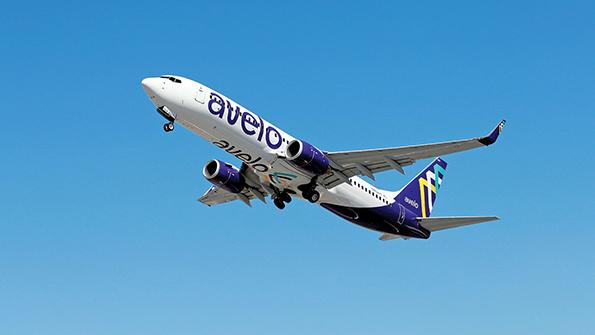
Avelo plans to add another Boeing 737-800 to its operations at Tweed New Haven Airport in Connecticut.
“Rapid” is an apt word for the breakneck ramp-up of startup Avelo Airlines, whose name was coined by the carrier to combine the roots of the Latin words for “route” and “speed.”
In just 18 months, the ultra-low-cost carrier has grown its fleet from two aircraft serving 11 cities from its single Burbank, California, base and has stretched its wings east of the Mississippi. It is operating three bases—soon to be five—a fleet of 14 Boeing 737NGs, and serving 34 destinations with point-to-point, out-and-back service. This is similar to Allegiant Air’s model, but in some ways different, too. Since its inaugural flight from Burbank to Santa Rosa, California, on April 28, 2021, the Houston-based discounter has hired more than 550 crewmembers and has carried more than 1.5 million passengers on about 12,000 flights.
- The ultra-low-cost carrier looks for riches in niches
- Retaining pilots and revenue have been challenges
Avelo co-founder and CEO Andrew Levy, an industry veteran who was chief financial officer at United Airlines and president of Allegiant Travel Co., portrays Avelo as small but mighty. “There’s some benefits to just scale when you’re small like we are,” he says. “Ten to 20 aircraft is really powerful because there’s very little overhead that’s required, but you get a lot more activity on that overhead. So that’s huge in terms of driving down your unit costs.”
Avelo does not plan to stay diminutive for long. “We’re going for 70-80% growth in 2023,” Levy adds. “There’s going to be a massive increase in routes between now and even the summer. By the end of this year, I bet you we’re close to maybe 50 cities and 100 routes.”
Instead of a one-size-fits-all approach—a la Allegiant—of connecting small airports with outbound traffic to a leisure destination, Avelo is opportunistically developing different strategies for each of its bases, often centered around an alternative airport.
“[Burbank was] the best thing we had going in 2022, without a doubt confounding the naysayers and skeptics,” the founder says. Avelo has built a brand awareness in the Los Angeles market, but most of its traffic originates from small underserved spoke cities without nonstop service such as Eugene, Oregon; Pasco, Washington; and Redding, California. Avelo is also pursuing nonbase flying, such as connecting Santa Rosa in California’s wine country with Las Vegas and Palm Springs, California. There may be some growth there, with another 737 added to the Burbank base.
Avelo’s most high-profile base is Tweed New Haven Airport in Connecticut, to which another 737-800 is to be added. It is a small airport serving a large catchment area in Connecticut, New York, Rhode Island, and Massachusetts. Back in 2020, the airport saw all of its commercial airline service cease due to complications from the COVID-19 pandemic. “New Haven is truly unique in many ways,” Levy says. “We feel it is going to be really good for us over time.”
Most of the 14 nonstop flights from Tweed serve destinations in Florida. Additional seasonal flights to Chicago Midway International Airport and Savannah, Georgia, are also in the mix, as Avelo aims to expand to 20 destinations from Tweed New Haven. The bulk of Tweed’s point-of-sale is for New England customers heading southbound. Six 737s based at the airport, including some higher-gauge 737-800s with short-field performance packages, enable non-weight-restricted departures to Florida from the short runway, which is due for expansion.
Last spring, the optimism about New Haven turned sour. “We were clobbered by astronomical jet fuel prices,” Levy notes, attributing that to high state taxation and pipeline costs. “When you think about a stress test for a business, I don’t think a $7-8 per gallon price of jet fuel would’ve ever even entered the imagination.”
Avelo’s third base, at Orlando, Florida, is a departure in strategy. “Orlando reminds me of what we did at Allegiant, connecting Orlando nonstop to underserved markets like the Lansings and Kalamazoos [in Michigan] and Daytons [in Ohio], with most of the traffic being inbound.”
For its next phase at Orlando International Airport, the carrier envisions retaining exclusivity on most routes but skimming some traffic off the top of some routes flown by competing carriers such as Delta Air Lines, Frontier Airlines, Southwest Airlines and Spirit Airlines. Avelo intends to scale up to about 10 aircraft to support the base over the next five years. For now, Avelo’s only directly competitive route is to its new base at Raleigh, North Carolina.
The airline is expanding to another new base at Wilmington Airport in Delaware on Feb. 1, another location that has no existing commercial service. Frontier recently left the airport. “Nobody’s been able to really make Wilmington work before, but we’re approaching it in a way that’s just simply different, and we expect that we’ll have a different outcome,” Levy says.
Wilmington shares similarities with New Haven in that it has a large local catchment area, which encompasses Delaware, northeast Pennsylvania including Philadelphia, southern New Jersey and Baltimore.
Of all its planned bases, Raleigh is the outlier. Levy calls it an “experiment”—Avelo is serving Raleigh-Durham International Airport because no alternate airport is nearby. He notes that Raleigh has great demographics, a growing market, an optimal geographic location and the lowest fuel prices in the network. Four of the markets from which Avelo flies to Florida and New Haven have no competition, while three others do.
Avelo’s “fail fast and move on” strategy is demonstrated by its abandonment of seven locations since its launch. However, Levy points to the success of the Burbank base as proof that patience is important—a second-year maturity is kicking in, with fares and schedule optimized and brand awareness emerging.
The discontinued use of 50-seat regional jets and the ongoing deterioration of regional connectivity are unlocking an upside in exactly the types of small markets Avelo serves. “[There are] infinitely more opportunities today than there were 15 years ago with a hub-overflying strategy. I expect that trend will continue,” Levy says. Consolidation in the ultra-low-cost carrier space could spur some competition as well. “If Spirit actually does get acquired, then that’ll create different opportunities. I’d call us an interested observer,” he adds.
It has not all been smooth air for Avelo. The recruiting of experienced talent that was more widely available, sometimes furloughed by other carriers, was touted as an advantage early on but is now more of a challenge—and pricier. Recruiting and training pilots has not been the problem, but retaining them has. To stay competitive, Avelo has raised pilot hourly rates twice, with a third increase imminent.
Financially, Avelo is nearing completion of its third—and what Levy says he hopes is the final—round of raising private capital, accumulating a total of $150 million. The carrier’s most recent financial reports to the Transportation Department revealed a loss of $23.8 million on $52.5 million in revenue in the first half of 2022. “While a -45% margin is nothing to be proud of, it dwarfs [in a good way] the -129% margin of Breeze in the same quarter,” reports airline industry news website Enilria.com
Neither the company nor the Transportation Department has released more current numbers. “We saw significant improvement over the first half of the year,” says Jim Olson, head of communications at Avelo.
Levy is bullish about the carrier’s finances, but admits that Avelo is “still trying to get both the revenues higher and the costs lower to be able to get to a sustainable, profitable business.” He says the company was “solidly profitable” in December 2022 and expects it to be in the black for the full year of 2023. In December, Avelo achieved a system-wide record 84% load factor, which Levy expects to exceed in the coming year.
Operationally, the ascent has not been as smooth as Avelo touts. FlightAware data reveals that an average of 24% of flights were delayed in the fourth quarter of 2022, with an average delay of 46 min.
Levy concedes that the young carrier needs to improve its on-time game. The company’s customer-friendly “soul of service” mantra is manifested in how it has recovered from service “irregular operation” disruptions and delays, he says. “We try to go above and beyond and make it right with our customers,” Levy says. “After a certain number of hours delay, we’ll give you an original form of payment and we’ll give you a credit for the inconvenience.” Avelo is at the top of the industry for flight completions and it has one of the lowest rates of bag mishandling, Levy says.
Going forward, the CEO projects confidence. “We’re doing exactly what we set out to do, which is to seek out different airports, offer service that isn’t offered, bring great convenience to our customers and low fares,” he says. “Our purpose is to inspire travel and we’re doing just that.”
Editor's note: This article was updated to clarify information about Avelo's 2022 first-half financials, Andrew Levy's role at Allegiant Travel Co., the aircraft type Avelo plans to add at Burbank, the number of aircraft it aims to have at Orlando and the location of Avelo's directly competitive route.





